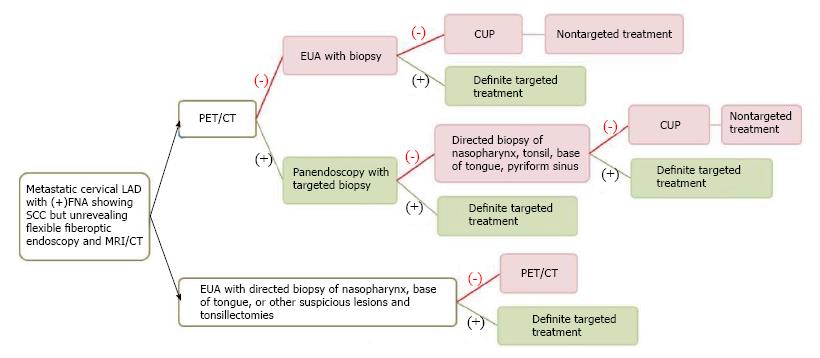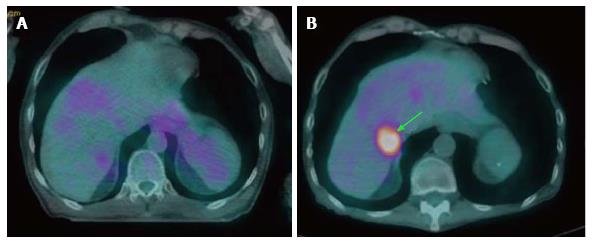Copyright
©The Author(s) 2016.
World J Otorhinolaryngol. May 28, 2016; 6(2): 23-32
Published online May 28, 2016. doi: 10.5319/wjo.v6.i2.23
Published online May 28, 2016. doi: 10.5319/wjo.v6.i2.23
Figure 1 Algorithm in diagnosis and management of carcinoma of unknown primary.
LAD: Lymphadenopathy; FNA: Fine-needle aspiration; SCC: Squamous cell carcinoma; MRI: Magnetic resonance imaging; PET/CT: Positron emission tomography/computed tomography; EUA: Examination under anesthesia; CUP: Carcinoma of unknown primary.
Figure 2 Occult squamous cell carcinoma of the right palatine tonsil.
The lesion (green arrow) was not appreciated on physical examination, flexible endoscopy and contrast-enhanced CT (A), but demonstrated hypermetabolic activity on PET/CT with maximal SUV: 3.5 (B). Biopsy directed by PET/CT revealed squamous cell carcinoma of the right palatine tonsil. The right level IIA lymphadenopathy also showed increased FDG uptake (yellow arrow). The patient remained disease free for 5 years after treatment. PET/CT: Positron-emission tomography/computed tomography; SUV: Standardized uptake value; FDG: 2-fluoro-2-deoxy-D-glucose.
Figure 3 Complete treatment response at primary tumor site.
Squamous cell carcinoma of the left palatine tonsil (arrows) was seen on contrast-enhanced CT (A) and pre-treatment PET/CT (B) with maximal SUV: 11.6. The tumor was no longer hypermetabolic on PET/CT with maximal SUV: 2.8 at 10 wk after treatment (C). PET/CT: Positron-emission tomography/computed tomography; SUV: Standardized uptake value.
Figure 4 Complete response of metastatic cervical lymph node.
Left level IIa metastatic lymphadenopathy (arrows) from the same patient in Figure 3 with squamous cell carcinoma of the left palatine tonsil was identified on both contrast-enhanced CT (A) and pre-treatment PET/CT (B) with maximal SUV: 12.1. After treatment, the lymph node was no longer hypermetabolic at 10-wk PET/CT (C) with maximal SUV: 2.5, representing complete response. PET/CT: Positron-emission tomography/computed tomography; SUV: Standardized uptake value.
Figure 5 Residual primary tumor.
Squamous cell carcinoma of the right base of tongue (arrows) was identified on contrast-enhanced CT (A) and pre-treatment PET/CT (B) with maximal SUV: 10.2. The tumor remained FDG-avid on PET/CT (C) with maximal SUV: 4.8 at 12 wk after treatment, representing residual disease. PET/CT: Positron-emission tomography/computed tomography; SUV: Standardized uptake value.
Figure 6 Recurrent primary tumor detected by positron-emission tomography/computed tomography.
Squamous cell carcinoma of the base of tongue (green arrows) with bilateral level IIa metastatic lymphadenopathy (yellow arrows) was identified on pre-treatment PET/CT with maximal SUV: 13.2 (A). The tumor remained intensely hypermetabolic on PET/CT with maximal SUV: 6 at 13 mo after treatment (B). PET/CT: Positron-emission tomography/computed tomography; SUV: Standardized uptake value.
Figure 7 Failure of treatment due to distant metastasis.
A: Pre-treatment PET/CT of the patient with squamous cell carcinoma of the base of tongue in Figure 6 did not reveal any increased FDG uptake in the liver; B: PET/CT performed at 13 mo after treatment showed new hepatic metastasis (arrow), representing treatment failure. PET/CT: Positron-emission tomography/computed tomography; FDG: 2-fluoro-2-deoxy-D-glucose.
- Citation: Nguyen VD, Tantiwongkosi B, Weinheimer WJ, Miller FR. Positron-emission tomography/computed tomography imaging in head and neck oncology: An update. World J Otorhinolaryngol 2016; 6(2): 23-32
- URL: https://www.wjgnet.com/2218-6247/full/v6/i2/23.htm
- DOI: https://dx.doi.org/10.5319/wjo.v6.i2.23















